|
A Study of the Effects
of Factors Related to Food Consumption in Health
Workers of Najaf Abad-based Healthcare Centers,
Isfahan, Iran
Fereshteh Sarmadi
Correspondence:
Fereshteh Sarmadi*
MSc in Nutrition, Health Network Najaf Abad,
Isfahan University of Medical Sciences,
Isfahan, Iran
Tel: 09132334301
|
Abstract
Introduction & Objective:
The present study aimed to investigate
the effects of factors related to food
consumption (demographic, culture and
customs, awareness, and attitudes) in
health workers of Najaf Abad-based healthcare
centers, Isfahan, Iran, in 2012.
Methodology:
In this cross-sectional study, 167 health
workers participated. The sampling method
was simple random sampling, which was
conducted through tables of random numbers.
The acceptable inclusion and exclusion
criteria were the interest of all healthcare
personnel working in Najaf Abad-based
healthcare centers to participate in the
study, and there were no other criteria.
For data analysis, the descriptive statistics
and regression analysis were used. Additionally,
the SPSS Statistics Software Version 18.0
was utilized.
Findings:
The results of the present study revealed
that the bread and ce real group had the
highest mean of consumption in employees
(4.4±9.1). Moreover, it was demonstrated
that the factors affecting the consumption
of bread and cereals were as follows:
attitudes, and customs, spouse employment,
monthly income, head of the household,
age, marital status, and family size (p<0.05).
Conclusion:
Nowadays, multiple data sources publish
and educate on nutrition in which unscientific
and contradictory nature of the sources
causes confusion, thereby leading to making
wrong decisions. Education was also a
factor influencing food choices in employees.
Therefore, coordinating training with
the level of education is a major factor
that should be considered for proper planning.
Therefore, it is suggested that the underlying
factors be recognized before education
in advance to improve nutrition and prevent
diseases caused by malnutrition.
Key words:
Food Consumption, Health Workers, Health
Network
|
In today’s world, people’s lifestyles
have undergone massive changes, from traditional
to industrial modes of living. In addition,
due to various developments in food supply,
people’s access to a variety of industrial
and processed foods has increased. These foods
are usually high in calories and low in nutritional
value, not to mention, a significant percentage
of women and men are employed, and this situation
has not allowed them enough time to prepare
their own food at home, thereby having a propensity
for fast foods and processed foods.
On the other hand, the statistics reported
in nutritional studies indicate that obesity,
overweight and their related diseases, such
as cardiovascular diseases and diabetes, are
highly prevalent in societies. For example,
the results of a study conducted by Tadayon
(2008) revealed that 40% of the population under
study had obesity and overweight problems in
Najaf Abad County, Isfahan, Iran. The results
also demonstrated that 45-50% of workers and
employees were overweight or fat (1).
Overweight and obesity-related illnesses are
prevalent, too. According to the statistics
collected in 2011, the cardiovascular, cancerous
and metabolic diseases were the first, second
and fourth causes of death in Najaf Abad County,
Isfahan, Iran (2).
According to the reports presented by the department
of non-communicable diseases of Najaf Abad-based
healthcare centers in 2011, there were 418 and
915 patients with diabetes and blood pressure,
respectively (3).
Additionally, the results of a study done
by Dastanpour et al. (2006) revealed that 30%
of the inhabitants of Isfahan Province, Iran,
were overweight, 10.4% were fat, and 3.1% were
obese. According to the same survey, 5.5% of
the population under study had high blood pressure
and 17% had a history of diabetes. The results
of this study also demonstrated that the average
cholesterol measured 190, and 62.7% of the population
under study had cholesterol levels equal to
or greater than 200 (4), which were caused by
obesity, overweight and related diseases (e.g.,
diabetes, high blood pressure, increased blood
fat, cardiovascular diseases, and cancer), sedentary
lifestyle and poor intake of food groups.
Therefore, many factors play efficacious roles
in food choices. More to the point, the results
of various studies in this respect are indicative
of the fact that people do not follow suitable
patterns in food consumption, and employees
are among the groups in which the prevalence
of malnutrition is significantly high and their
food patterns are not suitable.
In a study performed by Afrouzian et al. (2006),
the knowledge of cardiovascular patients and
the employees of Arak-based healthcare centers,
Markazi, Iran, about healthy nutrition was investigated,
and the results revealed that doctors and nurses’
knowledge about the oil consumption measured
86.7% as opposed to 74.2% in health experts.
Further, the results indicated that the percentage
of the consumption of protein sources and oilseeds,
fruits and vegetables were as follows respectively:
doctors (81%, 48%, and 98%), nurses (73%, 30%,
and 75%), and health experts (83%, 45%, and
98%) (22).
In another study on the knowledge and performance
of female health workers in Flaverjan County,
Isfahan, Iran, the results showed that 61% of
the employees did not know how much they had
to eat, and 27%, 33% and 65% of them did not
eat breakfast, dinner and snacks, respectively.
Furthermore, the results revealed that 44.4%
and 59% of the participants in the study did
not eat main courses and snacks, respectively
(23).
In a study conducted about the food consumption
patterns of employees at Tabriz University of
Medical Sciences, Rastibrojeni et al. (2008)
found out that the patterns were not appropriate,
and there were significant differences between
the male and female employees in terms of the
consumption of grains, liver, biscuits, pasta,
ice cream, milk, walnuts, pepper, pomegranate,
and peach. In this study, it was suggested that
necessary measures be employed to improve the
eating habits of the male population (24).
Compared to other groups in society, health
workers had better nutritional information because
they took training courses on this issue every
year. Thus, according to the observations and
interviews that I had with health workers and
given the prevalence of problems and concerns
for nutrition in this group and the role of
nutrition in the development of chronic diseases,
we decided to study food groups in health care
workers because employees are the custodians
of public health. Therefore, the present study
aimed to investigate the effects of factors
related to food consumption (demographic, culture
and customs, knowledge, and attitude) in health
workers of Najaf Abad-based healthcare centers,
Isfahan, Iran, in 2012.
In this cross-sectional study, 167 health workers
participated. The sampling method was simple
random sampling, which was conducted through
tables of random numbers. The acceptable inclusion
and exclusion criteria were the interest of
all healthcare personnel working in Najaf Abad-based
healthcare centers to participate in the study,
and there were no other criteria. The sample
size was calculated through the following formula,
in which the confidence coefficient measured
s=1.96=96%, and s=0.18=d.
The data collection tool was a self-made questionnaire
that included the following sections: 1) demographic
characteristics, 2) culture and customs, 3)
awareness, 4) attitudes), and 5) information
on food intake. To assess the validity of the
questionnaire, a group of five nutrition experts
was consulted. Moreover, to assess the reliability
of the questionnaire, it was distributed among
30 members of the target population and their
information was collected. Further, the reliability
of the questionnaire was confirmed using the
Cronbach’s alpha coefficient (=0.75). For
data analysis, the descriptive statistics and
regression analysis were used. Additionally,
the SPSS Statistics Software Version 18.0 was
utilized.
of the target population and their information
was collected. Further, the reliability of the
questionnaire was confirmed using the Cronbach’s
alpha coefficient (=0.75). For data analysis,
the descriptive statistics and regression analysis
were used. Additionally, the SPSS Statistics
Software Version 18.0 was utilized.
Click
here
for
Table
1:
Consumption
of
Food
Groups
by
the
Health
Workers
of
Najaf
Abad-based
Healthcare
Center
in
2012
Based
on
the
Consumed
Units
per
Day
Table
2:
The
Major
Factors
Influencing
the
Consumption
of
Bread
and
Cereals
in
Health
Workers
of
Najaf
Abad-based
Healthcare
Center
in
2012
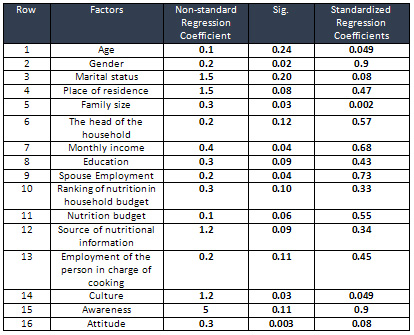
The
five
primary
factors
that
were
effective
in
the
consumption
of
bread
and
cereals
were
as
follows:
attitudes,
culture,
spouse
employment,
monthly
income,
head
of
the
household,
age,
marital
status
and
family
size.
These
factors
significantly
correlated
with
the
consumption
of
bread
and
cereals.
Table
3:
The
Major
Factors
Influencing
the
Consumption
of
Milk
and
Dairy
in
Health
Workers
of
Najaf
Abad-based
Healthcare
Center
in
2012
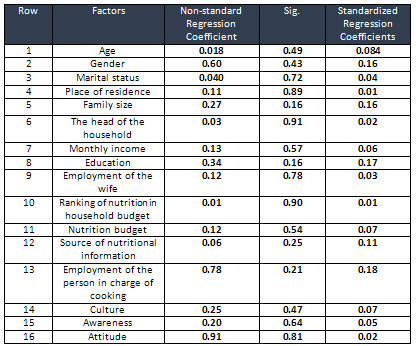
The
five
primary
factors
that
were
effective
in
the
consumption
of
milk
and
dairy
were
as
follows:
employment
of
the
person
in
charge
of
cooking,
education,
gender,
family
size,
and
source
of
nutritional
information.
These
factors
significantly
correlated
with
the
consumption
of
milk
and
dairy.
Table
4:
The
Major
Factors
Influencing
the
Consumption
of
Sugar
in
Health
Workers
of
Najaf
Abad-based
Healthcare
Center
in
2012
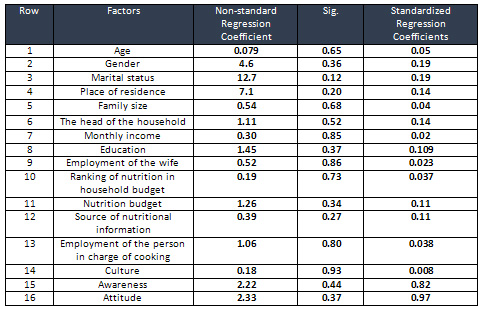
The
five
primary
factors
that
were
effective
in
the
consumption
of
sugar
were
as
follows:
attitudes,
awareness,
marital
status,
gender,
place
of
residence,
and
the
head
of
the
household.
These
factors
significantly
correlated
with
the
consumption
of
sugar.
Table
5:
The
Major
Factors
Influencing
the
Consumption
of
Fruits
in
Health
Workers
of
Najaf
Abad-based
Healthcare
Center
in
2012

The
five
primary
factors
that
were
effective
in
the
consumption
of
fruits
were
as
follows:
age,
family
size,
gender,
the
head
of
the
household,
and
awareness.
These
factors
significantly
correlated
with
the
consumption
of
fruits.
Table
6:
The
Major
Factors
Influencing
the
Consumption
of
Vegetables
in
Health
Workers
of
Najaf
Abad-based
Healthcare
Center
in
2012
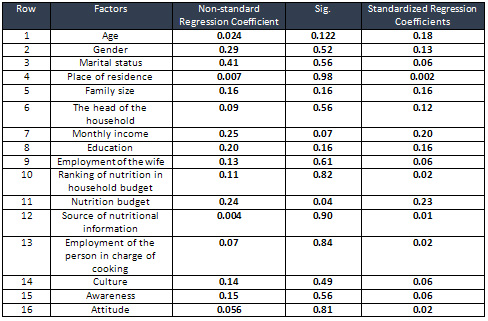
The
five
primary
factors
that
were
effective
in
the
consumption
of
vegetables
were
as
follows:
nutrition
budget,
monthly
income,
age,
family
size,
and
education.
These
factors
significantly
correlated
with
the
consumption
of
vegetables.
Table
7:
The
Major
Factors
Influencing
the
Consumption
of
Fast
Foods
in
Health
Workers
of
Najaf
Abad-based
Healthcare
Center
in
2012

The
five
primary
factors
that
were
effective
in
the
consumption
of
fast
foods
were
as
follows:
education,
gender,
marital
status,
monthly
income,
and
awareness.
These
factors
significantly
correlated
with
the
consumption
of
fast
foods.
Table
8:
The
Major
Factors
Influencing
the
Consumption
of
Restaurant
Foods
in
Health
Workers
of
Najaf
Abad-based
Healthcare
Center
in
2012.
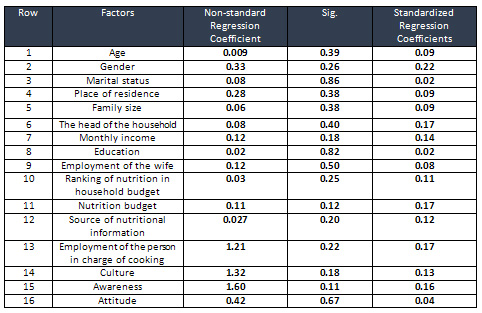
The
five
primary
factors
that
were
effective
in
the
consumption
of
restaurant
foods
were
as
follows:
gender,
the
head
of
the
household,
nutrition
budget,
employment
of
the
person
in
charge
of
cooking,
and
awareness.
These
factors
significantly
correlated
with
the
consumption
of
restaurant
foods.
Table
9:
The
Major
Factors
Influencing
the
Consumption
of
Meat
in
Health
Workers
of
Najaf
Abad-based
Healthcare
Center
in
2012
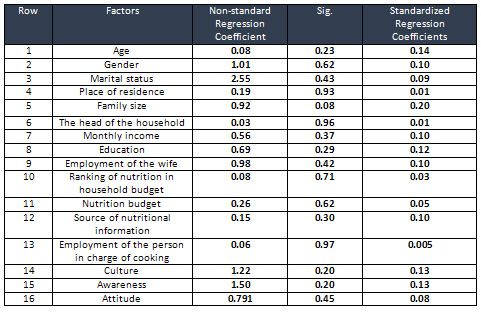
The
five
primary
factors
that
were
effective
in
the
consumption
of
meat
were
as
follows:
family
size,
age,
culture,
awareness,
and
education.
These
factors
significantly
correlated
with
the
consumption
of
meat.
Table
10:
The
Major
Factors
Influencing
the
Consumption
of
Oil
in
Health
Workers
of
Najaf
Abad-based
Healthcare
Center
in
2012

The
five
primary
factors
that
were
effective
in
the
consumption
of
oil
were
as
follows:
employment
of
the
person
in
charge
of
cooking,
nutrition
budget,
source
of
nutritional
information,
education,
and
family
size.
These
factors
significantly
correlated
with
the
consumption
of
oil.
Table
11:
The
Major
Factors
Influencing
the
Consumption
of
Foods
(Total
Calorie)
in
Health
Workers
of
Najaf
Abad-based
Healthcare
Center
in
2012
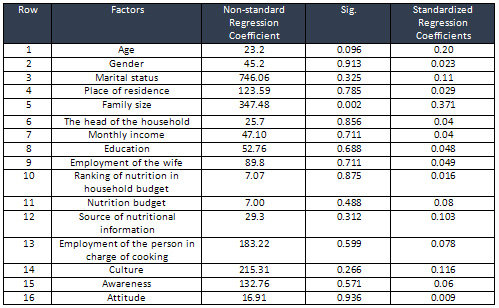
The
five
primary
factors
that
were
effective
in
the
consumption
of
foods
(total
calorie)
were
as
follows:
family
size,
age,
marital
status,
culture,
and
source
of
nutritional
information.
These
factors
significantly
correlated
with
the
consumption
of
foods
(total
calorie).
Table
12:
The
Role
of
Culture
and
Customs
in
Food
Choice
by
Health
Workers
of
Najaf
Abad-based
Healthcare
Center
in
2012

Table
13:
Awareness
of
the
Amount
of
Food
Groups
Consumed
by
Health
Workers
of
Najaf
Abad-based
Healthcare
Center
in
2012

| DISCUSSION
AND
CONCLUSION
|
The
statistics
announced
by
Iran’s
Institute
of
Industrial
Research,
Food
and
Nutrition
have
shown
that
the
intake
of
fruits,
vegetables,
milk
and
meat
in
Iranian
families
is
lower
than
the
recommended
limits,
while
the
consumption
of
bread
and
cereals
exceeds
the
recommended
limits.
For
example,
the
intake
of
the
following
items
exceeds
the
recommended
amounts
by
the
mentioned
values:
vegetables
(2.8
units),
fruits
(one
unit),
milk
and
dairy
(0.7
units),
meat
(1.8
units),
bread
and
celeries
(14
units),
and
other
items
(40%)
(5).
Studying
the
risk
factors
of
non-communicable
diseases
across
Isfahan
Province,
Iran,
in
2006
showed
that
the
residents
of
this
province
ate
one
unit
of
fruit
and
1.2
units
of
vegetables
on
average,
and
90%
of
the
population
ate
lower
than
five
units
of
fruits
and
vegetables
per
day,
while
the
minimum
recommended
intakes
of
fruits
and
vegetables
were
two
and
three
units,
respectively.
The
results
also
indicated
that
68.2%
of
the
inhabitants
of
this
province
ate
fish
fewer
than
once
per
month.
The
results
also
revealed
that
56.4%
used
vegetable
oil
as
opposed
to
liquid
oil
consumed
by
42%
of
the
participants
in
the
study
(6).
In
another
study,
the
relationships
between
awareness,
attitudes
and
performance
with
fields
of
study
and
academic
terms
of
students
staying
at
the
dormitories
of
Shahid
Beheshti
University
of
Medical
Sciences
were
investigated.
The
results
of
this
study
demonstrated
that
all
medical
students
had
appropriate
awareness
about
milk
and
dairy
products,
but
their
attitudes
and
other
factors
affected
their
consumption
(9).
The
availability
of
food
can
play
effective
roles
in
food
choices.
For
example,
in
a
study
done
by
Jafari
et
al.
(2008),
the
results
indicated
that
the
availability
of
dairy
products
at
home
could
be
effective
in
their
consumption
(10).
Rasti
et
al.
(2008)
showed
that
having
enough
time
to
prepare
and
consume
foods
was
a
major
factor
in
choosing
foods.
In
addition,
it
was
shown
that
44%
and
59%
of
the
health
workers
under
study
did
not
eat
main
courses
and
snacks,
respectively
(11).
In
another
study
conducted
by
Rezazadeh
et
al.
(2006),
the
results
showed
that
unhealthy
food
patterns
correlated
with
place
of
residence
(North
or
South),
ethnicity,
age,
education,
monthly
income,
and
the
area
of
the
house
(12).
In
a
study
conducted
by
Shakerinejad
et
al.
(2006),
the
results
revealed
that
the
food
consumption
patterns
of
students
were
dependent
on
family
budget
(13).
In
another
study
done
by
Peneauus
et
al.
(2009),
the
effects
of
environmental
factors
on
food
intake
and
choice
of
beverage
during
meals
were
investigated
in
teenagers.
The
results
of
this
study
indicated
that
the
monthly
income,
gender,
parents’
employment
and
men’s
participation
in
preparing
meals
played
effective
roles
in
this
regard
(14).
The
results
of
a
study
performed
by
Jilcott
et
al.
(2009)
revealed
that
watching
T.V.,
listening
to
music
when
one
is
hungry
and
thirsty
and
eating
alone
or
in
a
group
were
effective
in
food
choices
(15).
In
a
study
performed
by
Delvaj
et
al.
(2007),
it
was
shown
that
the
availability
of
healthy
and
unhealthy
foods
in
American
schools
and
their
economic,
social
and
ethnic
status
played
major
roles
in
their
food
choices
(16).
Moreover,
the
social
customs
were
reported
as
a
major
factor
in
food
choices
by
the
London
Department
of
Health
(17).
In
a
study
done
by
Mckie
et
al.
(1998),
it
was
found
out
that
food
choices
were
different
in
urban
and
rural
areas
because
there
were
more
fast
food
restaurants
and
supermarkets
in
cities,
and
the
circle
of
friends
and
colleagues
as
well
as
environmental
factors
were
among
the
effective
factors
(18).
Additionally,
lack
of
coordination
between
the
nutritional
education
and
available
foods
was
also
an
important
factor
affecting
food
choices
(19).
The
results
of
a
study
done
by
Waq
&
Mavoa
(2006)
revealed
that
lack
of
time
management
and
friends
and
family
members
were
among
the
most
important
factors
influencing
food
choices
(20).
Afrouzian
et
al.
(2006)
found
out
that
60%
of
the
population
under
study
had
adequate
information
about
the
consumption
of
fish,
but
due
to
lack
of
suitable
groundwork
to
use
their
information,
they
did
not
have
a
desirable
performance
(21).
The
results
of
the
present
study
indicated
that
family
size,
age,
marital
status,
culture
and
customs
and
sources
of
nutritional
information
were
among
the
most
important
factors
in
choosing
foods.
Awareness
and
attitudes
have
been
reported
as
effective
factors
in
food
consumption
in
many
studies.
However,
these
two
factors
had
trifling
effects
on
food
consumption
because
this
group
had
better
awareness
and
attitudes
compared
with
other
groups.
Rezazadeh
et
al.
(2006)
showed
that
unhealthy
food
patterns
correlated
with
place
of
residence,
ethnicity,
age,
education,
monthly
income
and
the
area
of
the
house
(12).
The
results
of
the
present
study
were
consistent
with
this
study
in
terms
of
the
correlations
between
unhealthy
food
patterns
and
each
of
age,
education,
and
culture
and
customs.
In
many
studies,
it
has
been
shown
that
social
and
ethnic
status
correlates
with
food
intake.
This
finding
is
consistent
with
the
results
of
the
present
study
in
which
culture
and
customs
correlated
with
food
consumption.
Moreover,
the
results
of
the
present
study
showed
that
sources
of
nutritional
information,
marital
status,
employment
of
the
person
in
charge
of
cooking
and
nutrition
budget
were
among
the
factors
that
correlated
with
the
consumption
of
certain
food
groups.
In
households
where
both
husband
and
wife
work
outside
the
home,
access
to
healthy
and
fresh
food
items,
such
as
vegetables
and
dairy
products,
become
difficult.
As
the
results
of
the
present
study
indicates
dairy
and
vegetable
consumption
in
this
group
is
lower
than
what
is
recommended
because
they
do
not
have
enough
time
to
prepare
their
own
healthy
meals.
Hence,
the
forgoing
items
should
be
taken
into
consideration
to
improve
the
food
consumption
pattern
in
this
group,
and
appropriate
planning
should
be
made
in
this
respect.
Culture
and
ethnic
and
local
customs
and
inadequate
financial
and
economic
conditions
in
crowded
and
densely
populated
families,
poorly
planned
and
insufficient
household
budgets
are
some
of
the
factors
that
should
be
taken
into
account
in
interventions
and
improving
the
nutritional
patterns.
Increasing
age
and
declining
physical
and
financial
power
are
other
major
factors
that
affect
the
food
consumption
of
health
workers.
The
results
of
the
present
study
showed
that
the
consumption
of
meat,
fast
foods,
sugar
and
oil
was
higher
than
the
recommended
limits.
The
results
of
the
present
study
was
consistent
with
the
results
of
other
studies
in
terms
of
the
consumption
of
fast
foods,
sugar
and
oil,
while
these
results
were
inconsistent
with
the
results
of
other
studies
in
terms
of
the
consumption
of
meat
because
those
who
do
not
have
the
opportunity
to
cook
food
and
do
not
have
access
to
healthy
food
are
forced
to
eat
fatty
and
sugary
foods
which
are
easy
to
make.
These
foods
usually
have
better
appearance,
tastes
and
shapes,
and
that
is
why
they
are
chosen
first.
In
this
regard,
the
results
of
the
present
study
demonstrated
that
one’s
culture
and
customs
are
major
factors
involved
in
choosing
foods.
The
source
of
nutritional
information
was
another
factor
that
was
felt
to
be
associated
with
food
choices.
In
addition,
the
circle
of
friends
and
colleagues
and
rumors
were
other
important
factors
in
choosing
foods.
Nowadays,
multiple
data
sources
publish
and
educate
nutrition
whose
unscientific
and
contradictory
nature
of
the
sources
cause
confusion,
thereby
leading
to
making
wrong
decisions.
Education
was
also
a
factor
influencing
food
choices
in
employees.
Therefore,
coordinating
training
with
the
level
of
education
is
a
major
factor
that
should
be
considered
for
proper
planning.
Therefore,
it
is
recommended
that
the
underlying
factors
be
recognized
before
education
in
advance
to
improve
nutrition
and
prevent
diseases
caused
by
malnutrition.
To
improve
the
feeding
pattern
of
Employees,
the
problems
and
issues
that
lead
to
the
wrong
selection
of
foods
should
be
taken
into
consideration.
To
do
so,
careful
planning
is
important,
and
the
required
interventions
can
be
put
into
action
based
on
the
presented
plans
and
solutions,
thereby
laying
the
groundwork
for
honing
their
performance
in
this
respect.
Further,
it
is
suggested
that
similar
studies
be
performed
in
other
populations
in
order
to
avoid
parallel
work
that
causes
confusion
and
discourages
officials.
If
the
foregoing
items
are
considered
in
planning
and
interventions,
achieving
the
ultimate
goal,
i.e.,
reforming
the
patterns
of
food
consumption
and
reducing
diseases
caused
by
malnutrition,
will
be
easier
and
faster.
1.
Tadayon,
Giti
(2008).
A
Report
of
the
Statistics
in
Najaf
Abad
County.
Department
of
Health,
Najaf
Abad
County,
Isfahan,
Iran.
2.
Sarmadi,
Fereshteh
(2007).
A
Study
of
Workers
and
Employees
in
Najaf
Abad
County.
Department
of
Health,
Najaf
Abad
County,
Isfahan,
Iran.
3.
Tadayon,
Giti
(2008).
A
Report
of
the
Statistics
in
Najaf
Abad
County.
Department
of
Health,
Najaf
Abad
County,
Isfahan,
Iran.
4.
Dastanpour,
Masoumeh;
Heidari,
Kamal;
Fadaie,
Reza
(2006).
A
Study
of
Risk
Factors
of
Non-communicable
Diseases
in
Isfahan
Province.
Department
of
Health,
Isfahan
University
of
Medical
Sciences.
5.
Sheykholeslam,
Robabeh
(2003).
A
Study
of
Food
Consumption
in
Iran.
Nutrition
Newsletter.
Ministry
of
Health
and
Medical
Education.
6.
Dastanpour,
Masoumeh;
Heidari,
Kamal;
Fadaie,
Reza
(2006).
A
Study
of
Risk
Factors
of
Non-communicable
Diseases
in
Isfahan
Province.
Department
of
Health,
Isfahan
University
of
Medical
Sciences.
7.
Tadayon,
Giti
(2008).
A
Report
of
the
Statistics
in
Najaf
Abad
County.
Department
of
Health,
Najaf
Abad
County,
Isfahan,
Iran.
8.
Gholampour,
A.
(2008).
A
study
of
the
consumption
and
attitudes
of
middle
school
girls
about
fast
foods
in
Razieh
Middle
School,
Isfahan,
Iran.
The
10th
Iranian
Nutrition
Congress.
Tehran
University
of
Medical
Sciences.
9.
Ramazankhani,
Ali
(2007).
A
Study
of
the
Relationship
between
Awareness,
Attitudes
and
Performance
with
Fields
of
Study
and
Academic
Terms
of
Students
Staying
at
the
Dormitories
of
Shahid
Beheshti
University
of
Medical
Sciences.
The
10th
Iranian
Nutrition
Congress.
Tehran
University
of
Medical
Sciences.
10.
Jafari,
Farhad;
Mosavi,
Tahereh,
Khezri,
Nahid
(2008).
A
Study
of
the
Availability
of
Dairy
Products
Consumed
by
adolescent
Girls
in
the
South
East
of
Tehran.
The
10th
Iranian
Nutrition
Congress.
Tehran
University
of
Medical
Sciences.
11.
Rasti
Brojeni,
Razieh;
Soleymani,
Darcheh
(2008).
A
Study
of
the
Awareness
and
Performance
of
Female
Health
Workers
in
Flaverjan
County
about
Food
Consumption.
The
10th
Iranian
Nutrition
Congress.
Tehran
University
of
Medical
Sciences.
12.
Rezazadeh,
Arezoo;
Rashidkhani,
Bahram;
Omidvar,
Nasrin;
Hoshyarzadeh,
Anahita;
Setayeshgar,
Zohreh
(2006).
A
study
of
the
relationship
between
the
dominant
food
patterns
and
economic,
social
and
demographic
status
of
women
aged
20-50
residing
in
the
north
of
Tehran,
Iran.
The
ninth
Iranian
Nutrition
Congress.
Tabriz
University
of
Medical
Sciences.
13.
Shakerinejad,
Ghodratolahh;
Tavakoli,
Elham;
Jaroondi,
Farzaneh;
Hajinajaf,
Saeedeh;
Lorizadeh,
Mohammad,R.;
Keykhani,
Bijan
(2006).
A
study
of
Food
Consumption
Patterns
in
the
Treatment
of
Iron
Deficiency
Anemia
in
Female
Middle
School
Students
in
Ahwaz.
The
ninth
Iranian
Nutrition
Congress.
Tabriz
University
of
Medical
Sciences.
14.
Peneauus
.
Mekhm
,ukh
A.
chapelot,D
.
DailiaXAM
,
A.
irinei
,G.Hercberg,
S
.
Bellisle
,F.Ifluenes
of
environmental
facors
on
food
intake
and
choice
of
beverage
during
meals
in
teenagers
:
a
laboratory
study.
Brjnutr.
2009
DEC
:
102
(12
):
1854
–
9
15.
Jilcott
,SB.
laralia
,BA
.
Evenson,
KR.
Ammerman,
AS.
16.
Perceptions
of
the
community
food
environment
and
related
influencies
on
food
choice
among
midlife
women
residing
in
rural
and
urban
areas:
a
qualitative
analaysis
school
of
medicine,
East
Carolina
.Women’s
health.2009
mar-may:
49(2-3):164-80.
17.
Delvaj,
O.
Malleypm
.Johnston,
LD
Availability
of
more
–
healthy
and
less
–
healthy
food
choices
in
American
schools:
a
national
study
of
grade,
racial
/
ethnic
/
and
socioeconomic
differences
.Amj
prev
med.2007
oct:
33(4supp):s226-39.
18.
Croker,
H
.Whitaker,
KL.
Cooke,
L.
Wardle,
J.
Do
social
norms
affect
in
intended
food
choice
?
Prev
Med.2009
aug-sep:
49(2-3):190-3.
19.
Mckie,
L.
Clark,
GM.
Maclellan,
M.
Skerratt,
S
.The
promotion
of
healthy
eating
:
food
availability
and
choice
in
Scottish
island
communities.
Health
edu
res.1998
sep:13(3):371-82
20.
Waq,
A.
Mavoa,
H.
Sociocultural
Factors
influencing
the
food
choices
of
18
–
16
years.
Pac
health
dialog.2006
sep:13(2):57-64.
21.
Afrouzian,
M;
Yazdan
Karimi,
T.;
Behzad,
Hamed;
Pourghasem,
B.
(2006).
A
study
of
the
nutritional
awareness
of
health
workers
about
fish
consumption
in
Imam
Khomeini
and
Sina
health
centers.
The
ninth
Iranian
Nutrition
Congress.
Tabriz
University
of
Medical
Sciences.
22.
Tahernejad,
F;
Ansari,
R;
Bahonar,
A;
Khosravi,
A.;
Ilamieh,
A.;
Mohammadifar,
N.
(2006).
A
Study
of
the
Awareness
and
Performance
of
Health
Workers
Concerning
the
Consumption
of
Healthy
Foods
in
Health
Centers
Based
in
Isfahan.
The
Ninth
Iranian
Nutrition
Congress.
Tabriz
University
of
Medical
Sciences.
23.
Rasti
Brojeni,
Razieh;
Soleymani,
Darcheh
(2008).
A
Study
of
the
Awareness
and
Performance
of
Female
Health
Workers
in
Flaverjan
County
about
Food
Consumption.
The
10th
Iranian
Nutrition
Congress.
Tehran
University
of
Medical
Sciences.
24.
Baba
Yaaan
Amiri,
S.;
Hassanzadeh,
K;
Karimi,
T.;
Afrouizian,
M.;
Aliasghari,
F.;
Pourabdolahi,
P.
(2008).
A
Comparison
of
the
Food
Consumption
Patterns
of
Female
and
Male
Employees
at
Tabriz
University
of
Medical
Sciences.
The
10th
Iranian
Nutrition
Congress.
Tehran
University
of
Medical
Sciences.
|

